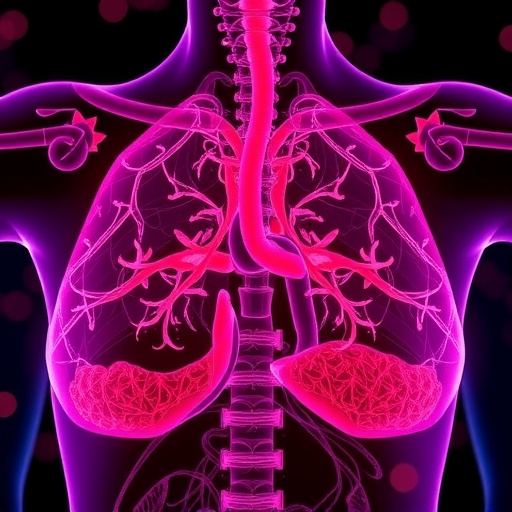
In the relentless pursuit of advancing cancer therapeutics, researchers have unearthed a promising new avenue to amplify the effectiveness of radiotherapy in breast cancer treatment. A groundbreaking study, recently published in Cell Death Discovery, reveals that targeting iron regulatory protein 2 (IRP2) to disrupt iron metabolism significantly enhances radiosensitivity in breast cancer cells, primarily by inducing mitochondrial dysfunction. This novel insight propels a deeper understanding of how iron homeostasis intertwines with cancer cell survival and resistance to radiation, setting the stage for innovative therapeutic strategies that could dramatically improve patient outcomes.
Iron, an essential metal ion pivotal to numerous cellular processes, plays a dual role in cancer biology. While it supports cell growth and proliferation through its involvement in DNA synthesis and metabolic activity, excess iron can catalyze the production of reactive oxygen species (ROS), leading to oxidative stress and cell damage. The intricate regulation of intracellular iron is mediated by Iron Regulatory Proteins (IRPs), with IRP2 emerging as a key modulator in maintaining iron homeostasis. The study highlights that breast cancer cells exploit IRP2 to sustain their iron metabolism pathways, fostering resilience against therapeutic interventions such as radiation.
Radiotherapy remains a cornerstone in breast cancer management; however, intrinsic and acquired radioresistance often diminishes its efficacy, leaving many patients vulnerable to recurrence and metastasis. The newly elucidated role of IRP2 in this resistance mechanism stems from its regulation of iron availability, which in turn affects mitochondrial function—the powerhouse of the cell intimately linked to apoptotic pathways and oxidative stress response. By perturbing IRP2 function, researchers have demonstrated a critical vulnerability in cancer cells, where impaired iron metabolism compromises mitochondrial integrity, thereby sensitizing cells to radiation-induced damage.
.adsslot_j2PKSbqzXs{width:728px !important;height:90px !important;}
@media(max-width:1199px){ .adsslot_j2PKSbqzXs{width:468px !important;height:60px !important;}
}
@media(max-width:767px){ .adsslot_j2PKSbqzXs{width:320px !important;height:50px !important;}
}
ADVERTISEMENT
Utilizing a combination of genetic knockdown models and pharmacological inhibitors specific to IRP2, the study delineates a clear causal relationship between IRP2 inhibition and heightened radiosensitivity in various breast cancer cell lines. These manipulations led to pronounced mitochondrial dysfunction, characterized by diminished membrane potential, disrupted electron transport chain activity, and elevated mitochondrial ROS production. This mitochondrial collapse effectively undermines cellular defenses against radiation, culminating in increased DNA damage, apoptotic signaling, and ultimately, cell death.
The mechanistic exploration further delves into iron’s pivotal role in the mitochondrial electron transport chain, particularly its incorporation in iron-sulfur clusters essential for electron transfer. IRP2 disruption results in altered expression of key iron metabolism genes, reducing mitochondrial iron import and impairing electron transport chain function. Consequently, the generated ROS surges beyond the neutralizing capacity of cellular antioxidants, pushing cancer cells toward irreversible oxidative damage when exposed to ionizing radiation.
A compelling facet of this research lies in its translational applicability. By pinpointing IRP2 as a novel target, the study paves the way for the development of adjunct therapies that can be co-administered with radiotherapy. Such combined modalities hold the potential to lower radiation doses required to achieve tumor control, thereby mitigating collateral damage to healthy tissues and minimizing side effects commonly associated with radiation treatment.
Moreover, the investigation broadens the perspective on mitochondrial dynamics in cancer therapy resistance. Mitochondria, beyond their conventional metabolic roles, function as central hubs integrating various stress signals. Their susceptibility to iron metabolism perturbations unveils a strategic chokepoint that can be exploited to subvert cancer cell survival mechanisms, bringing mitochondrial modulation to the forefront of oncological research.
Interestingly, the study also touches upon the role of ferritin, the iron storage protein, whose expression inversely correlates with IRP2 activity. Reduced ferritin levels ensuing from IRP2 inhibition lead to increased labile iron pools, further exacerbating mitochondrial oxidative stress. This iron-mediated toxicity culminates in heightened radiosensitivity, delineating an intricate balance where fine-tuning iron storage and utilization dictates cancer cell fate.
Crucially, the researchers employed advanced imaging and molecular biology techniques to verify their findings. High-resolution confocal microscopy, flow cytometry, and Western blot analyses collectively affirmed alterations in mitochondrial morphology, membrane potential, and expression of apoptotic markers post-IRP2 targeting. Such multi-modal approaches lend robust validity to the proposed mechanism, underscoring the therapeutic relevance of IRP2.
The implications extend beyond breast cancer, as aberrant iron metabolism and mitochondrial dysfunction are hallmarks observed in diverse malignancies. Thus, the therapeutic targeting of IRP2 may represent a broadly applicable strategy, potentially revolutionizing how radiosensitivity is modulated across cancer types and enhancing the universal efficacy of radiation therapy.
Importantly, safety profiles and specificity of potential IRP2 inhibitors remain critical considerations. Future research will necessitate rigorous preclinical and clinical evaluations to ascertain the selectivity of such compounds for cancer cells, minimizing off-target effects on normal tissues where iron regulation is equally vital. Balancing therapeutic gain against possible toxicities will be paramount in translating these findings into clinical reality.
The study also opens intriguing questions regarding the interplay between iron metabolism and other cancer survival pathways. For instance, how IRP2-related iron dysregulation interfaces with hypoxia-inducible factors, autophagy, and immune responses within the tumor microenvironment remains ripe for investigation. Clarifying these complex networks will unravel novel combinatorial treatment regimens that integrate metabolic targeting with conventional therapies.
Another avenue worthy of exploration lies in patient stratification. Identifying biomarkers that predict responsiveness to IRP2-targeted radiosensitization could optimize personalized treatment plans, ensuring that therapies are tailored to exploit specific metabolic vulnerabilities in tumor cells. Such precision medicine approaches promise improved therapeutic indices and patient quality of life.
In summary, the intricate study on IRP2 presents a transformative perspective on cancer therapy by coupling iron metabolism disruption with mitochondrial dysfunction to overcome radioresistance. It marks a pivotal step in the ongoing efforts to unveil metabolic Achilles’ heels within cancer cells. As investigative efforts continue, the integration of metabolic insights with traditional oncologic treatments holds the potential to redefine therapeutic standards, empowering clinicians with new tools to combat breast cancer’s formidable resilience.
Subject of Research: Targeting iron regulatory protein 2 (IRP2) to disrupt iron metabolism and enhance radiosensitivity in breast cancer cells through mitochondrial dysfunction.
Article Title: Targeting iron regulatory protein 2 (IRP2) to disrupt iron metabolism enhances radiosensitivity through mitochondrial dysfunction in breast cancer cells.
Article References:
Jeong, Y.Y., Hwang, J., Park, A. et al. Targeting iron regulatory protein 2 (IRP2) to disrupt iron metabolism enhances radiosensitivity through mitochondrial dysfunction in breast cancer cells. Cell Death Discov. 11, 357 (2025). https://doi.org/10.1038/s41420-025-02653-z
Image Credits: AI Generated
DOI: https://doi.org/10.1038/s41420-025-02653-z
Tags: breast cancer treatment advancementscancer cell survival mechanismsenhancing radiotherapy effectivenessinnovative cancer therapeutic strategiesiron metabolism in cancerIRP2 and radiosensitivitymitochondrial dysfunction in breast cancerovercoming radioresistance in breast canceroxidative stress and cancerrole of iron in cancer biologytargeting iron regulatory proteinsunderstanding iron homeostasis in tumors





